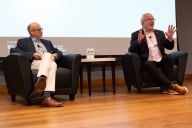You have /5 articles left.
Sign up for a free account or log in.
The word of the hour is “endemic.”
COVID, we now hear, is poised to become an endemic disease: surging irregularly but ever present. COVID’s prevalence may diminish, but that’s certainly no guarantee that its severity or impact will fade.
As Jeff Selingo has observed, this will force colleges and universities to rethink educational and business models that hinge on “students learning, living, eating, and being entertained in a physical location” and interacting in person.
But COVID is not, I think the only endemic reality that our institutions face. There’s also:
- A rapid increase in the share of students with certified disabilities and mental health problems.
- A rising number of nontraditional students, including first-generation students, transfer students, economically disadvantaged students, adult learners and family caregivers.
- A climbing proportion of students with uneven academic preparation pursuing degrees in highly demanding fields.
Some adaptations will occur relatively effortlessly. Think virtual office hours or advising sessions—options that should have existed years ago.
Then there are shifts that will require a bit more effort and expense but which make obvious sense. For example, campuses need to ensure that all class lectures are video- or audio-recorded and captioned and that all PowerPoint presentations are uploaded.
Also, campus workshops, seminars, talks, theatrical performances, concerts and conferences should be available remotely—and not just to students. Why not engage alumni and your institution’s friends?
Other adjustments will certainly be more difficult but are essential nonetheless.
1. Accommodating everyone
Why shouldn’t students who are ill be able to attend class remotely? Why shouldn’t those with complicated demands on their time be able to take classes? Why shouldn’t every class be designed to allow every student to fully participate?
We now know from firsthand experience that it’s possible to eliminate many of the barriers that restricted access or impeded students from getting the support that they need in the past.
No longer is it sufficient to make accommodations on a one-by-one basis. In my big U.S. history survey, over 15 percent of my students have certified disabilities, and many more students who haven’t registered with our campus disabilities center face similar challenges.
Our solutions must be scalable. Thus, I, perhaps like you, have embraced universal design for learning principles. I have abandoned proctored examinations in a classroom and substituted a wide range of lower-stakes assessments: online quizzes, frequent response papers, oral presentations, term papers that involve multiple steps and various kinds of authentic ways to evaluate learning.
2. Promoting post-pandemic pedagogies
The pandemic has forced all of us to reconsider our approach to teaching, making us more aware of the stresses and inequities that inhibit student learning and the need to be more approachable, flexible and humane. We’ve also learned the importance of maximizing and monitoring student engagement, tracking student learning more closely and making our classes more interactive, immersive and well organized.
As the pandemic becomes endemic, we will need to draw upon the lessons we have picked up. Here are some tips:
- Create Slack or Teams-like backchannels where students can share ideas and opinions and raise questions related to the course.
- Utilize educational technologies that promote active learning, including annotation, collaboration, data and text analysis, and visualization tools.
- Gamify the course experience by allowing students to accumulate points by completing certain activities (for instance, undertaking a research scavenger hunt or solving course-related problems).
- Treat students as teachers or knowledge creators by having them introduce a class session, run a discussion, contribute to a course blog or wiki, or create a presentation, an infographic, a podcast or a video story.
- Combine rich, meaningful online, remote and in-person educational experiences by developing interactive courseware, designing field projects and remote learning opportunities, and architecting classroom activities that do not mimic what can be done virtually.
3. Reimagining student life
Even at institutions without masking or social distancing requirements, campus life has not returned to normal. Anxiety, loneliness, depression and a sense of disconnection remain widespread. Community building, in other words, is more important than ever.
Social engagement, I suspect, is as valuable a contributor to students’ mental health and well-being as psychological counseling.
My answer: small-group activities. Examples include freshman interest groups, thematically focused learning communities and cohort programs, makerspaces, expanded research and intramural athletic opportunities, wellness activities, and regular check-ins in dormitories. Those small group activities should also include organized outdoors and off-campus excursions, whether faculty-student lunches or visits to a museum, a performance venue or activities in nature itself.
COVID has been a catalyst for campus transformation, disrupting standard operations; intensifying pre-existing demographic, enrollment and financial challenges; and accelerating a host of innovations in instructional and service delivery.
I think it would be a grave mistake to view the emerging post-pandemic new normal as a glass half-empty. The old ways of doing business had great value, but let’s imagine a more connected and more flexible campus.
At that next-generation institution, the boundaries between the online and the on campus and the face-to-face and the virtual will blur. Lower-density interactions will become more commonplace. We will do more to connect every student to a faculty mentor, a cohort, an adviser and support services, both in person and digitally. Students’ mental health and well-being will be higher institutional priorities.
I’d also urge campuses to establish a new kind of “course”: a scaled interdisciplinary community of inquiry to examine a targeted campus, local or regional, national or global issue, which should certainly include breakout sessions and should also propose next steps.
We know what to do: reconsider the status quo. Emphasize engagement. Cultivate community. Remove barriers. Build personal connections. Prioritize flexibility. Stay nimble.
Just do it.
Steven Mintz is professor of history at the University of Texas at Austin.







